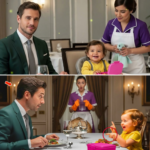
It was a hot and heavy Friday morning when the worn-out walls of a public school echoed with laughter and the shuffle of children’s slippers. In a fourth-grade classroom, Teacher Marta, her bun slightly crooked and eyes tired from a long school year, handed out blank sheets of paper to her students. “Draw someone you admire,” she told them. It was the last day before the holiday break, and the assignment was open-ended.
In the back of the room, almost hidden among tilted desks, sat Clara—a quiet, serious 9-year-old with dark, heavy eyes and two messy braids. She was small and silent, never disruptive, and often overlooked. No one at school talked much about her, but some knew bits of her story. Her mother worked cleaning jobs at night, and her father had been in prison for years. Even so, Clara was always prepared—homework done, pencils sharpened, never a complaint. While most kids started sketching soccer players, superheroes, and YouTubers, Clara slowly placed her paper on the desk and began drawing with delicate, thoughtful lines. She was drawing someone familiar, someone she’d never met but felt deeply connected to—Leonardo, the singer.
She couldn’t remember when she first heard his voice, but she remembered clearly the day her mother came home, eyes swollen from crying, holding a wrinkled letter and an old radio. The song “Pense em Mim” played softly from its speaker, and since then, it became a sort of ritual. Lying on a thin mattress in the cramped concrete house she shared with her mother and younger brother, Clara listened to the song almost daily. Its lyrics spoke of pain, longing, and hope—everything Clara felt but couldn’t express.
That day, Clara didn’t draw Leonardo as she had seen him on posters or TV clips. Instead, she imagined him as an angel. She gave him large white wings that stretched nearly to the edges of the page, a golden halo over his head, and a red heart drawn on his chest. In his hands, a microphone. In his eyes, tears. At the bottom of the page, she wrote in big letters: “An angel who sings to heal pain.”
When Marta collected the drawings, she stopped when she saw Clara’s. She stared at it, then at the girl, but said nothing. With quiet care, she folded the drawing and placed it in her folder.
Over the weekend, the school hosted a small event to showcase the students’ artwork. Moved by Clara’s drawing, Marta pinned it prominently near the school’s entrance, next to a table with coffee and salt crackers. Someone took a photo. Someone else shared it on social media. Within hours, the image of Clara’s drawing went viral—thousands of likes, hundreds of comments. People were touched by the raw emotion of a child’s tribute. Among the flurry of shares, someone tagged Leonardo.
In Goiânia, Leonardo was at home when his daughter ran in with her phone. “Dad, look! A little girl from a public school drew you as an angel.” Groggy, he took the phone, zoomed in on the photo—and froze. There was something about the drawing that disarmed him. Maybe the red heart. Maybe the tears in the child’s version of his eyes. Or maybe the caption she wrote below. He clicked on the article that had been posted with the image and read Marta’s explanation about Clara and her story.
“I want to meet this girl,” he said, without thinking twice.
Three days later, without alerting the media, Leonardo boarded a quiet flight with just his producer and trusted driver. When he arrived at Clara’s school, he approached the gate and asked to speak with the principal. Marta, seeing him in person, nearly fainted. “I—I can’t believe it,” she stammered. “You came all the way here?” Leonardo smiled and replied softly, “I came to meet the angel who drew me with wings. I want to thank her.”
The school quickly arranged a small welcome. A staff member went to fetch Clara from class. When she walked into the room and saw Leonardo standing there, she froze. Her notebook slipped from her hands. “It’s you,” she whispered. “Yes, Clara,” he said, kneeling to her height. “I’m here, and I came to say thank you. Your drawing touched me more than you can imagine.” Clara didn’t know what to say. She simply smiled, eyes full of tears. He held her hand, and then hugged her. And in that plain little room, full of chalk dust and echoes of childhood, something magical happened. For a moment, the world stopped—just long enough for a child and a man she saw as an angel to truly see each other.
Word of Leonardo’s visit spread fast, but he asked for no fanfare. He wasn’t there to perform or be applauded—he was there to connect. After speaking with the school staff, he asked to visit Clara’s home. Marta joined him. They drove down unpaved roads, past open sewers, and finally arrived at a narrow alleyway. Clara’s mother, upon seeing him at her doorstep, dropped to the ground in disbelief. “I used to listen to your songs when I was pregnant with Clara,” she said, weeping. Leonardo entered the modest, crumbling home—three mattresses on the floor, an old fridge, barely any food. He sat with them, drank fresh coffee, and listened. He listened to stories of hardship, fear, survival. Then he made a promise: “You won’t go through this alone anymore. I’m going to take care of you.”
And he did.
Within a week, a team arrived to renovate the home. They installed new walls, furniture, appliances, and proper doors. Clara got a real desk, a tablet, headphones, and a shelf of books. Her mother received a steady job at a private clinic—with fair pay and health insurance.
But Leonardo didn’t stop there. Inspired by Clara’s drawing, he launched Anjos do Desenho—an initiative to support children who express their emotions through art. The first art exhibit showcased drawings from Clara’s school, and Clara herself was the guest of honor. Dressed in a soft blue dress that matched her braids, she stood on stage with shaking hands and spoke into the microphone: “I just wanted to draw someone who made me feel less alone.” Leonardo stood beside her, tears in his eyes, and applauded with everyone else.
Clara’s story spread across the country. And through it all, she stayed the same: a quiet, hopeful girl who now slept peacefully holding her sketchbook. Her drawing of Leonardo—angel wings, halo, tears—was framed and hung in their new living room, not as a tribute to a star, but as proof that even a child’s drawing can change a life.
Leonardo, too, was changed. He never sang “Pense em Mim” the same way again. Each time, he saw Clara’s face in the lyrics.
As Anjos do Desenho grew, offering free art classes in poor neighborhoods, Leonardo kept visiting. He sang softly in workshops. He told stories. In one session, a child drew Clara with wings, holding a pencil like a magic wand. The caption read: “The girl who saw an angel—and became one.” Leonardo saw it and cried. “I never thought I’d be an inspiration to anyone,” he said. “But Clara taught me that we can all be angels. We just have to see with our hearts.”
Years passed. Clara studied art and became a teacher. In her classroom, the same old drawing of Leonardo still hangs. And she tells her students, “One day, I drew an angel. And he came.” And for a second, the room always fills with a quiet, rare kind of hope—the kind born when someone believes in us, even before we know how to believe in ourselves.
One rainy morning, Clara—now grown—found a note slipped under her classroom door. It was from Sofia, one of her shyest students, who barely spoke in class but always drew in the margins of her notebooks. “Ms. Clara, I drew an angel too. But this time, it’s you. When you talk to us, it feels like the world stops, and we believe we can dream.” Clara sat down and cried—not from sadness, but from overwhelming gratitude. That night, she called Leonardo. “Hi, my winged girl,” he answered. “How’s your heart today?” “Beating strong,” she replied, through tears. “A student drew me as an angel.” Silence. Then he said, “Looks like the world turned. And now—you’re the inspiration.” They spoke for hours, as they often did. She told him she was thinking about writing a book. “Write it,” he said. “Let the world know that miracles still exist—some wear invisible wings. Like you.”
Months later, the book was ready. Titled The Wings I Drew, it was launched with help from Anjos do Desenho, which now had over 50 community hubs across Brazil. Clara wore white to the event, as if embodying the angel she once imagined. Leonardo stood beside her, older now, his hair gray but his voice kind. “She’s always had a different light,” he told the crowd. Clara opened the book and read the dedication:
“This book is for every child who draws what they can’t explain. For those who see wings where others only see silence. And for my first angel—who heard me, even without knowing I existed.”
The audience stood and applauded. People cried. In the front row, a little boy raised a sheet of paper. Another drawing. Another beginning.
News
Virgínia Rompe o Silêncio Sobre Leonardo no Hospital e Revela Mágoa Que Ninguém Imaginava
A segunda-feira começou tensa para o mundo sertanejo e para milhões de seguidores atentos a cada movimento da família Costa….
Virgínia rompe o silêncio, se recusa a visitar Leonardo no hospital e expõe ferida que vinha crescendo dentro da família
A madrugada de segunda-feira começou diferente. Ainda antes do sol nascer, portais de Goiás noticiaram que Leonardo havia sido internado…
Sumiço de Neymar em Paris e Story de Biancardi Acendem Alerta: Coincidência ou Recado Silencioso?
O silêncio, às vezes, fala mais alto do que qualquer pronunciamento. E foi exatamente esse silêncio que transformou a ausência…
O silêncio de Neymar, o sumiço repentino e a indireta de Biancardi que deixou tudo ainda mais tenso
Tudo aconteceu de forma silenciosa demais para ser normal. Sem anúncio oficial, sem justificativa clara e sem aquela movimentação típica…
O pedido inesperado das Marias para o Natal deixa Virgínia sem reação e derrete a internet
O clima já era de festa, casa cheia, risadas espalhadas pelos cômodos e aquele barulho gostoso de família reunida quando…
O Pedido de Natal das Marias que Deixou Virgínia em Choque e Derreteu a Internet
O Natal ainda nem chegou, mas um momento simples dentro de casa foi suficiente para emocionar, arrancar risadas e surpreender…
End of content
No more pages to load









